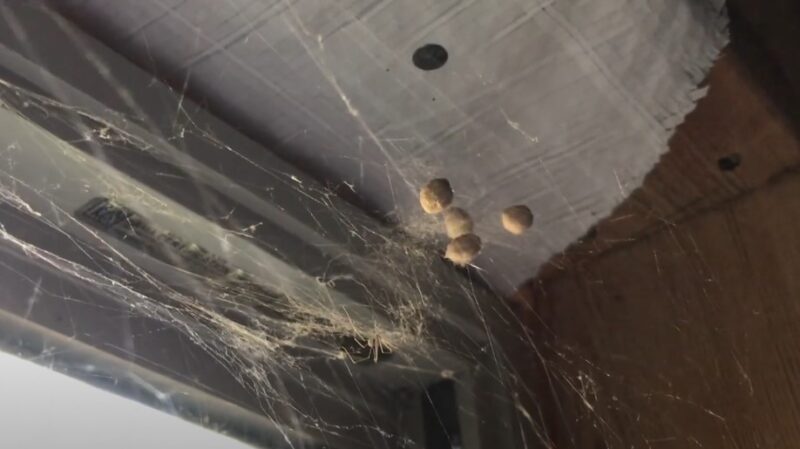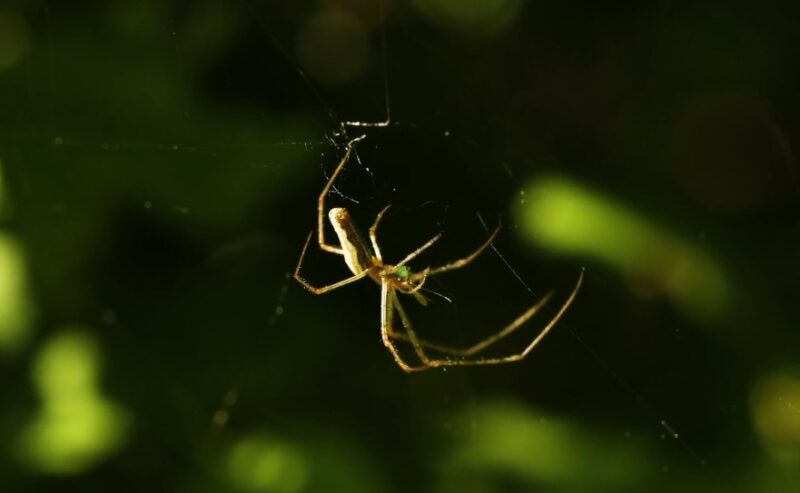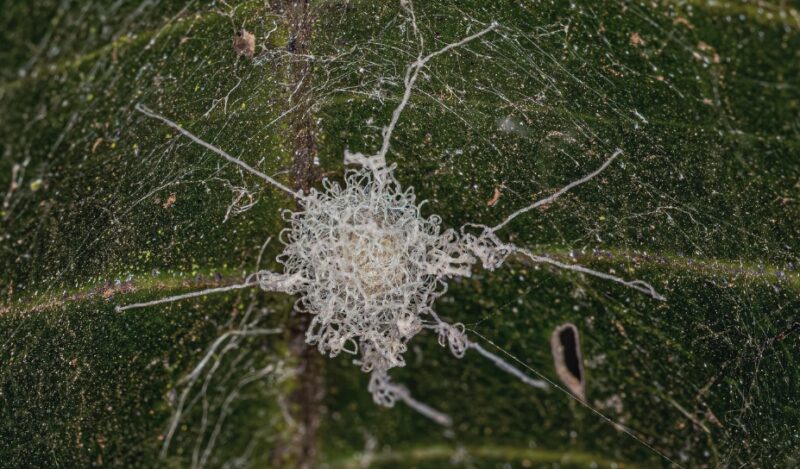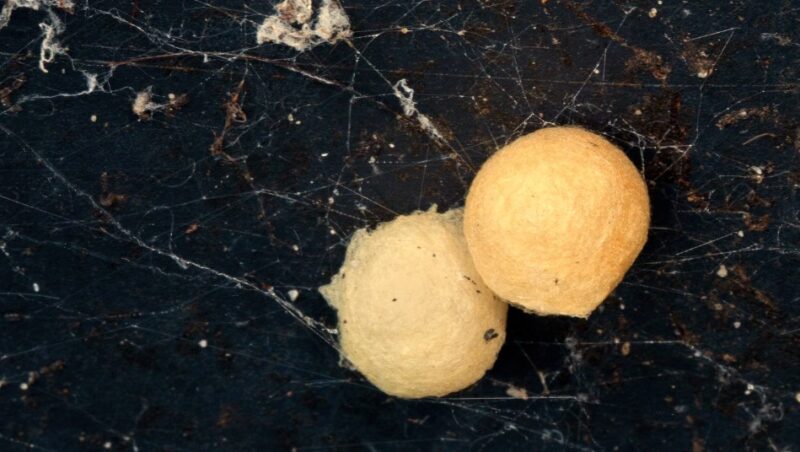Spiders have always fascinated and freaked out people in equal measure.
Their delicate webs, hunting tactics, and, of course, their eggs can be intriguing.
But what do spider eggs really look like, and where might you come across them?
If you’re curious (or even a little concerned) about spotting these tiny eggs in your home or garden, let’s take a closer look.
Key Takeaways
- Spider egg sacs are small, silk-covered, and often hidden in corners or vegetation.
- Size, shape, and color vary by species; sacs range from pea-sized to marble-sized.
- Indoors, eggs are commonly found in quiet areas like basements, attics, and closets.
- Outdoors, they may be attached to plants, trees, or hidden in soil and burrows.
- Spider eggs typically hatch in 2-3 weeks, with sacs holding anywhere from dozens to thousands of eggs.
- To prevent spiders from nesting, keep spaces clean, seal gaps, and use natural deterrents like essential oils.
Spotting Spider Eggs
Spider eggs are typically found nestled in a protective sac made of silk, a testament to the spider’s incredible weaving skills.
While you might expect something obvious, spider egg sacs are often small and can blend into their surroundings, making them easy to overlook unless you know what you’re looking for.
Size and Shape
Most spider egg sacs are quite small, sometimes no larger than a pea. But don’t let their size fool you; within that tiny sac could be anywhere from a few dozen to thousands of eggs.
The size of the sac itself can give you a clue about the species of the spider that laid it. For example:
- Pea-sized sacs: Likely from common house spiders.
- Pinhead-sized sacs: Possibly from smaller species like jumping spiders.
- Marble-sized sacs: Often belong to larger spiders, such as orb-weavers.
Color and Texture
The color of a spider egg sac can vary significantly.
You might find sacs that are almost transparent, making them tricky to spot.
More often, they’ll be white, yellow, or brown, depending on the species and how recently the eggs were laid.
Newly laid eggs have a milky or whitish hue, blending into light-colored surfaces.
As for texture, spider egg sacs can range from smooth and sleek to fuzzy or even spiked.
This texture depends on the density and arrangement of the silk threads, with some species creating thicker, more textured sacs for added protection.
Where to Find Spider Eggs

You don’t have to go far to find spider eggs—they could be hiding in plain sight in your home, garden, or just about anywhere that offers a bit of protection and privacy.
Let’s explore some of the common places spiders like to lay their eggs.
Indoors
If you’ve ever noticed a spider in your home, chances are it wasn’t far from its eggs. Indoors, spiders tend to choose quiet, undisturbed areas to deposit their egg sacs. Here are some prime spots:
- Corners of rooms: Check the upper corners of your walls, particularly those in less frequently used rooms. Spiders love the safety of high corners.
- Basements and attics: Dark, quiet, and out of the way, these spaces are perfect for spider egg sacs. You might find them behind furniture, in ceiling corners, or tucked away in storage boxes.
- Closets and storage areas: Closets that don’t see a lot of action are prime real estate for spider eggs. Keep an eye out for sacs in the corners or even attached to clothing that hasn’t been moved in a while.
Outdoors

Outside, spiders have an abundance of options for where to lay their eggs. Whether in your garden, among trees, or hidden in the ground, here’s where you’re most likely to spot them:
- Vegetation: Spiders often attach their egg sacs to the undersides of leaves, where they are less visible to predators. In your garden, look on plant stems, leaves, or within the crevices of bark.
- Tree branches and shrubs: Some species prefer to lay their eggs on branches or within dense shrubbery. The egg sacs are often secured with silk to blend in with their surroundings.
- Ground cover and soil: Ground-dwelling spiders like wolf spiders lay their eggs in burrows or under rocks. Unless you’re actively looking, these are often hidden from view.
Webs
Some spiders take the direct approach and lay their eggs right in their webs. This can make them a little easier to find if you’re familiar with where the spider tends to build.
- In the web: Many web-building spiders, like orb-weavers, will place their egg sacs in the center or a more concealed part of the web. This ensures the eggs are well-protected by the surrounding silk.
- Near the web: In other cases, the egg sac might be just outside the web, attached to a nearby surface like a wall, furniture, or a plant stem. This placement allows the spider to keep an eye on her eggs while still maintaining her web for catching prey.
The Spider Egg-Laying Process and Lifecycle

When it comes to laying eggs, spiders follow a methodical process, ensuring their offspring have the best chance of survival. Here’s how it usually goes down.
Egg-Laying
Female spiders begin by creating a mat of silk on which they deposit their eggs. Once the eggs are laid, they carefully wrap them in more silk, forming a protective sac.
Number of Eggs
The number of eggs in a single sac can vary widely depending on the species. Some spiders are minimalists, laying just a few dozen eggs, while others can pack hundreds or even thousands into a single sac. For example:
- Common house spiders: Typically lay 100 to 250 eggs per sac.
- Orb-weavers: Can lay up to 3,000 eggs in a single sac.
Incubation
@chasingbugs Little Bear laid eggs! #jumpingspider #petsoftiktok #cutepet ♬ animal crossing ~ new horizons lofi – Closed on Sunday
Spider eggs usually take about 2 to 3 weeks to hatch, though this can vary based on species and environmental conditions.
In colder climates or during winter, the incubation period may extend. During this time, the mother spider might stand guard, particularly in species known for maternal care.
Spiderlings
Once the eggs hatch, the tiny spiderlings often stay in the sac for a short period before venturing out.
In some species, the spiderlings will stick around with the mother for a while, but in others, they begin their independent lives almost immediately, dispersing to find their own territory.
Busting Common Myths About Spider Eggs
There’s no shortage of myths and urban legends when it comes to spider eggs. Let’s clear up a couple of the most common ones.
Myth 1: Spider Eggs in Bananas
You’ve probably heard the story of someone finding spider eggs in a banana. While it’s true that some tropical spiders might occasionally lay eggs in fruit, it’s incredibly rare.
Thanks to modern screening and inspection processes, the chances of encountering spider eggs in your grocery produce are almost nonexistent.
Myth 2: Spiders Lay Eggs Under Human Skin
This one’s a classic horror tale, but it’s just that—a tale. Spiders do not lay eggs in or on humans. Their reproductive habits are entirely directed toward creating and protecting egg sacs in safe environments, not using humans as unwilling hosts.
What to Do If You Find Spider Eggs

So, what if you come across a spider egg sac in your home? Here’s how to handle the situation.
Identification
First, take a close look at what you’ve found. If it’s small, round, and made of silk, chances are you’re dealing with a spider egg sac.
Removal
If you’d rather not share your space with potential spiderlings, removing the egg sac is a good idea. The safest method is to use a vacuum cleaner with a hose attachment.
This allows you to capture the sac without directly touching it. Alternatively, you can carefully pick it up with tissue or tweezers and dispose of it in an outdoor trash bin.
Keeping Spiders Out
To minimize the chances of spiders laying eggs in your home, keep things tidy and clutter-free. Regularly clean seldom-used spaces, seal any cracks or gaps in windows and doors, and consider using natural deterrents like essential oils.
Spiders tend to avoid areas with strong smells, so a little peppermint or citrus oil can go a long way in keeping them at bay.
Final Thoughts
Spider eggs are a small but important part of the life cycle of these incredible creatures.
Whether you find them fascinating or fear-inducing, knowing what to look for and how to handle them can make a big difference in your interaction with the world of spiders.
By keeping an eye out for these tiny sacs, you can better manage and understand the spider population in your environment, ensuring that both you and the spiders can coexist peacefully—or at least without any surprises.
Related Posts:
- Is Raising Guinea Fowl Right for You? An In-Depth…
- Why Male Kangaroos Don't Have Pouches - An In-Depth Look
- Jaguar vs. Cheetah - 10 Ways to Tell Them Apart
- The Spider-Tailed Horned Viper - One of Nature’s…
- Can Tarantulas Be Good Pets? Pros and Cons of Ownership
- Which Insects Can Survive Being Frozen and Reawaken…







